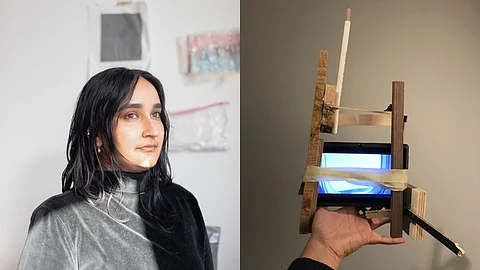
- HOMEGROWN WORLD
- #HGCREATORS
- #HGEXPLORE
- #HGVOICES
- #HGSHOP
- CAREERS
- ABOUT US
- CONTACT US

"A really easy way for a marginalised artist to attain a certain level of mainstream success in the commercial art world is to make the work about pain, exoticism, and otherness in the most legible, unchallenging way," Satpreet Kahlon says. "I am not interested in being a part of this dynamic."
The Punjab-born, Brooklyn-based artist was awarded the prestigious Foundwork Artist Prize on February 2 this year. Earlier this week, I interviewed her over email and asked her about the emphasis on illegibility and inscrutability in her practice which spans multimedia installations, sculpture, and community-engaged practices.
"For me, illegibility is a form of self-protection. It is a way of embracing, as Katherine McKittrick talks about in her book, 'Demonic Grounds', fugitivity as a kind of power," she answers.
"The very few indigenous cultures that have survived without being severely impacted by colonialism (although climate change is coming for everyone) have done so by being so remote, so small, and so hidden away, that they were not worth finding or exploiting. In the same way, I see power in creating work that is not for a universal audience, full of small spaces and images and videos that cannot really be seen or accessed."
Satpreet Kahlon
"I do this in my work a lot," she says, "hiding things away; making things hard to decipher. Not everything deserves to be seen by everyone. Just because I am an artist, and therefore put so much of myself up for display, doesn’t mean that I owe the audience everything. Some parts of the work are just for me or for my partner or for my friends or my community."
Drawing from her Punjabi heritage and diasporic experiences, Kahlon's artworks interrogate systems of power and belonging, blending traditional crafts with contemporary aesthetics, exploring themes of identity, indigeneity, displacement, colonial legacies, and cultural hybridity.
"If I think about the work as coming from an imperfect and gap-ridden legacy, it gives me the permission to begin from a place of failure, which is really freeing to me," she said. "Like, if I tell myself, 'This work cannot fix anything. It cannot go back in time and change the outcome for your family or your people. It cannot change the current trajectory of global politics. It can only help you make sense of and make poetry of the loss and longing you feel in your body everyday,' that’s a notion that allows me to remove the stakes from the work and create from a place of embracing my humanness. It removes the pressure."
"In the same way, I try to think of principles of indigenous cultures when I make — not necessarily making with 'pure' or 'valuable' materials; rather, creating with materials that are in excess; that are abundant, and embracing their history and inherent value. This is why I work with waste materials like cardboard, scrap wood, paper, and old embroidery materials, combining them with natural materials like lime, soil, clay, earth pigment, and wax."
"Even though one set of these materials is from a post-consumer sphere, where they have been processed and shipped around the globe in the service of an extractive global capitalism, and one set of materials is very much of the earth in their ‘pure’ form, by treating them similarly, I am interested in collapsing the differences in how they are perceived," she said. "Cardboard feels like tree bark to me. Wood still holds the history and soul of the tree. Even things like embroidery materials made of resin and plastic are derivatives of oil processes, which is called a fossil fuel because it is made of fossils — death and decay and histories that we all owe our existence to."
"By putting them all together, I hope to convey that all of these materials, to me, are alive, of this earth, of nature, just as I am, and the audience is, too."
Satpreet Kahlon
Kahlon frames this act of putting together a sculpture or an installation as a "futile attempt to communicate" with lost histories.
"I am deeply inspired by Sadiya Hartman’s work addressing gaps in the archive — and how these gaps are opportunities to speculate and dream of impossibility," she said. "If there is no record of my paternal family beyond my grandparents; if many of them were lost in the Partition, could I dream that they all escaped and live, even now, their descendants, in the mountains somewhere, free and happy?"
"For those of us who have little to no record, outside of stories our elders have told us, of our histories, there can be so much grief and mourning," she said. "For me, each sculpture, each piece, is like a beacon. I imagine the collapsing of space and time, and try to facilitate it through how I project and reflect video."
"It’s obviously an impossibility, as impossible as the belief that somehow our people might have not died violently, running from home, but that they escaped," the artist said. "And yet, if willing it allows us to expand our imagination beyond what our oppressors want us to think is possible — it can’t be an entirely futile exercise, right?"
About the artist
Satpreet Kahlon is a Punjab-born artist currently based in Brooklyn, New York. Her work spans multimedia installations, sculpture, and community-engaged practices, exploring themes of identity, displacement, colonial legacies, and cultural hybridity. Drawing from her Punjabi heritage and diasporic experiences, Kahlon's art interrogates systems of power and belonging, blending traditional crafts with contemporary aesthetics. She was recently awarded the 2024 Foundwork Artist Prize, an annual international juried award to support outstanding artistic practices.
Follow her here.
